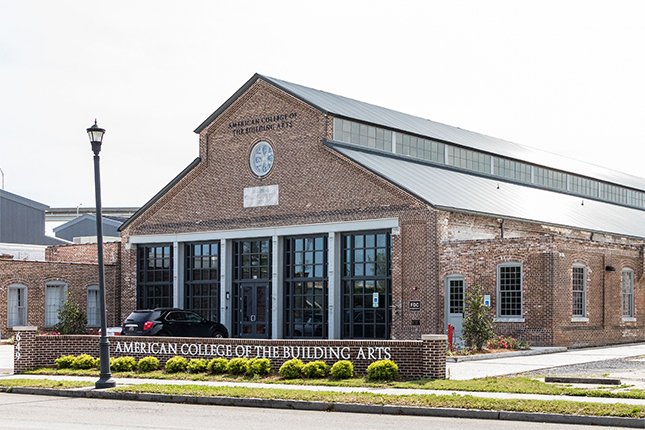It’s spring break, that annual week of debauchery that looms large in the lives of many college students. But at the American College of the Building Arts in Charleston, S.C., students are reluctant to leave school and take time away from their studies at all, let alone leave town on a vacation.
Take Bryson Youngblood Keefer, 21, for example. On the second day of spring break, this college junior is wearing a leather apron. His face covered in soot, he’s shaping iron into a frame for a small mirror. It’s a self-initiated project to match one he completed during winter break, when he also skipped a trip home to his native Los Angeles. “While I’m at the forge at this school, I’m very focused on the task at hand,” he says, confessing that he sometimes sleeps in his car outside the school to maximize his work time.
This is what we live and breathe.
India Lee, 27, a blacksmithing junior who hails from Indianapolis, is spending her spring break at the forge working on a mix of schoolwork and a personal project. “I’m seeing how I can manipulate metal into different shapes, playing with its plasticity,” she says. When asked whether there’s somewhere else she’d like to be while school’s out, she looks slightly puzzled. “This is what we live and breathe,” she says.
None of this is a surprise to Wade Razzi, the school’s chief academic officer. “If we let them,” he says, “the students would be here 24 hours a day.”
The American College of the Building Arts is a new kind of school located in a repurposed trolley barn just outside Charleston’s historic downtown. It offers an education in skilled building trades, such as timber framing, architectural carpentry, masonry, blacksmithing and architectural stone carving, paired with traditional four-year college subjects such as literature, history and science. That way, graduates acquire both highly marketable specialized skills and a bachelor’s degree. The school is quite small—at the moment, 75 students are enrolled—and quite young: It awarded its first degrees in 2009, to just seven students.
But despite its tiny size and tender age, the college has already had an outsized influence in Charleston and beyond, with students and alumni working on high-profile historic preservation projects around the world and close to home, including the city’s perennially popular Drayton Hall, an immaculately preserved 18th-century plantation. And it just might be a model for helping to solve a serious national issue: the growing gap between the jobs that are available and the number of people who are trained to fill them.

Charleston is the ideal place for such a solution to emerge. To understand why, you have to go back to before the city’s current economic success. Today, Charleston sits comfortably at number 16 on the Milken Institute’s Best-Performing Cities Index, a gain of six spots since 2017, on the strength of its high-tech GDP growth, for which it placed sixth in the nation. Median family income is $76,236, up 27.6 percent since 2012, and population growth outpaces the national average.
This stands in stark contrast to the past 100-plus years, when Charleston was, to put it plainly, a mess. The Civil War and Reconstruction ended its initial run of economic prosperity, which had been fueled in no small part by enslaved people. A veritable parade of natural and human-made disasters followed, including strong earthquakes, devastating fires and, of course, hurricanes.
But this litany of misfortunes has also led to what would be Charleston’s modern asset: The buildings that survived all this war and natural disaster, some dating to the 1700s, weren’t altered very much. “There’s a great expression here: ‘Charleston was too poor to paint and too proud to whitewash,’” says Kristopher King, executive director of the Preservation Society of Charleston. “Because of what was basically a 100-year economic recession, we didn’t get many new buildings.”
Either as an adaptation to circumstances or just a matter of taste, a preservation ethos emerged. “This is a community that’s always appreciated its unique urban form and architecture,” he says, pointing out that his organization was the first such preservation society in the country, founded in 1920, and that Charleston was also home to the nation’s first historic district.
Today that well-preserved history is a huge draw for both new residents and visitors to Charleston—“history and historic sites” is the first item on the list of the city’s greatest assets, according to the Office of Tourism Analysis at the College of Charleston. And draw them it does: Some 6.9 million tourists visited the area in 2017, generating $7.4 billion in total economic impact, according to the most recent figures.
“You can walk down the same street in Charleston every day for a decade and find something you never found before—there are so many layers and details,” says King “Maintaining the authenticity of those details is critical for preservation and the economic benefits that come from it. Austin has the saying Keep Austin Weird. We have Keep Charleston Real.”
